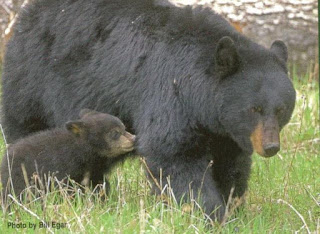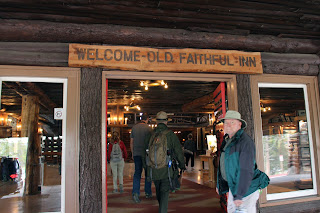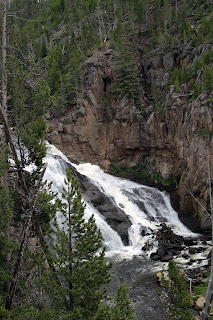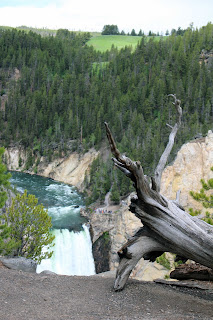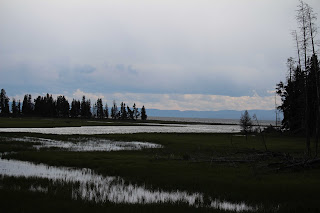After stopping for
a night in Laramie and Lander, we arrived at our destination in Moran, Wyoming
to spend the month of June to get an early start at the South entrance to
Yellowstone National Park. We stayed at the Grand Teton Park RV Park with a great view of the Tetons. It
was the closest RV Park to the south entrance. No bells and whistles, but it
had a country store, fuel, and a great view and it was close Yellowstone, Grand
Teton and Jackson Hole!
We had a pair of house swifts try to make a nest in our tail pipe so we had to chase them out! They weren't happy as they stared at us with nesting material in its mouth!
We met new RV
friends, Bob & Michelle who were motor cycle enthusiasts seeing the sites
fast and furious! We enjoyed a beautiful sunset and roasted s’mores over the
colorful campfire that Michelle stoked. As of the writing of this blog, they
are enjoying our home state of Florida with their new kayaks!
Yellowstone
National Park
Yellowstone
National Park encompasses more than two million acres of wild lands and open
spaces where animals like elk, wolves, and bison roam. It’s a place where
biological, geological, and hydrothermal processes each play a part in shaping
a fascinating, and constantly changing landscape. More than 400 miles of roads
and 1,000 miles of trails weave through this spectacular land that has been
protected “for the benefit and enjoyment” of the people since 1872.
We had never been
to Yellowstone National Park so you can imagine the excitement of this
adventure! We wanted to get to the park by June 1st to avoid the
crowds that we heard about, with long lines and bumper to bumper traffic. We
were so glad we did. We spent four days in the southern portion of Yellowstone.
Here is our photo journey! Sharon promised just photos in this blog, but there
is just so much to write about, she couldn’t resist!
Day 1 – Old
Faithful
We awoke at 6 a.m.
with the hope of seeing some grizzly bears on our drive to Old Faithful. There wasn’t a car on the road and it was a
little foggy. Since it was so
early, on the way into the park, the first beautiful view we saw was Oxbow
Bend. It was the most amazing setting with the Grand Tetons in the background
reflected on the water below. It was breathtaking and worth the stop!
There are
approximately 600 grizzly bears in the Greater Yellowstone Ecosystem. Males
weight 300-700 pounds, females 200-400 pounds. Adults stand about 3 ½ feet at
the shoulder. Grizzlies are agile and can run up to 35-40 mph. They can climb
trees but their curved claws and weight make this difficult. Their food
includes rodents, insects, elk calves, cutthroat trout, roots, pine nuts,
grasses and large mammals. Grizzlies mate in the spring and give birth the
following winter; typically 1-3 cubs. They live 15-30 years.
About an hour into
our drive, Sharon noticed a few cars stopped alongside the road ahead, so she
slowed down. As we approached, sure enough a mama grizzly bear with two cubs
were grazing on grass about a hundred yards off the road. Sharon got her camera
ready and just then the two cubs stood up at the same time and looked around
sensing trouble! In her excitement, Sharon tried to focus the telephoto lens,
but it would not focus as it had fogged up and she lost that photo. But the
experience of seeing the two cubs was so cool. The cubs went back to playing
and grazing and Sharon got a few photos of the mama and cubs. It was our first
experience with grizzly bears in the wild!
Sharon's blurry photo of the two cubs standing up!
Old
Faithful in Upper Geyser Basin
We took a Ranger
hike to see Old Faithful. Old Faithful is Yellowstone’s most famous geyser located in Upper Geyser Basin among many other spectacular geothermal features. Its predictability and impressive display make it the highlight of this day. The iconic geyser erupts into the air every 90 minutes or so. Each eruption lasts between 1 and 5 minutes, expels 3,700-8,400 gallons of boiling water, and reaches a height of 106-184 feet. Members of the Washburn Expedition of 1870 named this geyser for its consistent performance.
Our Ranger hike continued on to see and smell the largest concentration of geysers in the world. We walked along the Upper Geyser Basin boardwalk trail that twists through colorful hot springs and dormant lakeshore geysers.
The Old Faithful
Inn caused a revolution in national park architecture and established the
reputation of its young and gifted architect, Robert Chambers Reamer. Possibly the most iconic building in all of the National Park system and a National Historic Landmark. The Inn's lobby, which is open to the public, remains its most recognizable feature. The expansive atrium features exposed beams, tiers of balconies, and log staircases as well as a massive 15 1/2 foot wide rhyolite fireplace fronted by a handcrafted metal clock with a face 5 feet in diameter and a 14-foot pendulum. In total, it has been said over ten thousand logs were used in the Inn's lower story and more than 500 tons of stone make up the fireplace.
When Frank Jay
Haynes, the official photographer for the Northern Pacific Railroad, first
visited Yellowstone National Park in 1881, he took over 200 photos, making him
among the first of a contingent of photographers and artists to visit this
remote and seldom-visited wilderness. In 1883, he was selected as the official
photographer for U.S. President Chester A. Arthur’s visit, and suddenly became
a nationally recognized name.
His photographs brought to life the written accounts of Yellowstone’s spectacular landscape of erupting geysers, colorful hot springs, abundant wildlife, and the Grand Canyon of the Yellowstone and its thundering waterfalls.
F. Jay Haynes didn’t miss a year of working inside the Park until his death in 1921 – a dedication carried on by his son, Jack Ellis Haynes, that resulted in an 84-year presence of the Haynes family and their “picture shops” inside the Park.
Yellowstone
memorabilia collectors and historians, Jack and Susan Davis, spent many years
amassing a sizeable collection of Yellowstone and Haynes memorabilia before
donating it to the Yellowstone Park Foundation in 2001. The Foundation then
gave it to the museum collection in Yellowstone, where some of it is displayed
at the restored Old Faithful Haynes Photo Shop. Don’t miss the Haynes Photo
Shop as it tells the story of Yellowstone’s history!
Fountain
Paint Pot in Lower Geyser Basin
At the Lower
Geyser Basin we hiked the trail to see four types of hydrothermal features: hot
springs, geysers, mudpots, and fumaroles. Each feature requires the same
ingredients: plumbing (cracks in the earth through which water can flow), heat,
earthquakes (to keep the plumbing systems from clogging themselves), and
water. The water comes from the rain and
snow melt. As the snow melts each spring, water percolates down through cracks
in the earth until it comes into contact with heated brine a few miles beneath
the surface. Because hot water is less dense than cold water, the hot water
begins to rise back toward the surface and emerges as one of the types of
hydrothermal features depending on the plumbing in the area.
Fountain Paint Pot is Yellowstone's most famous mudpot.
Fountain Paint Pot is Yellowstone's most famous mudpot.
After we left the Fountain Paint Pot, we drove and stopped to admire the wildlife.
After lunch, we turned onto Firehole Lake Drive, a 3-mile, one-way circuit that winds past Great Fountain Geyser, the White Dome and Pink Cone geysers, and Firehole Lake, with run-off in every direction.
Early explorers thought that the large bubbles in Firehole Spring looked like flashes of light -- hence the origin of the spring's name.
No record of Pink Cone erupting exists until 1887. From 1889 to 1936, it seemed to be dormant; then for the next 23 years, it erupted approximately every two days. Through the years, the time between eruptions has increased to approximately 20 hours; the duration is about 100 minutes; and it erupts up to 30 feet. Small amounts of manganese oxide cause Pink Cone's color.
After lunch, we turned onto Firehole Lake Drive, a 3-mile, one-way circuit that winds past Great Fountain Geyser, the White Dome and Pink Cone geysers, and Firehole Lake, with run-off in every direction.
Early explorers thought that the large bubbles in Firehole Spring looked like flashes of light -- hence the origin of the spring's name.
Firehole Lake’s thermal waters flow through the forest here, giving trees a skeletal appearance of stark white stockings and gray trunks. The absorption of sinter (dissolved minerals) kills the trees but acts as a preservative, delaying their decay.
Grand
Prismatic Hot Spring in Midway Geyser Basin
Midway Geyser Basin is the location of Grand Prismatic Spring, Excelsior Geyser
Crater, as well as other interesting features.
Midway Geyser Basin is the location of Grand Prismatic Spring, Excelsior Geyser
Crater, as well as other interesting features.
Midway Geyser Basin is the location of the colorful Grand Prismatic Hot Spring, the largest hot spring in the park. The Grand Prismatic Hot Spring is also the largest thermal hot spring in the U.S. and the third largest in the world, falling shy of New Zealand’s Frying Pan Lake and Dominica’s Boiling Lake. Taking the photos from the boardwalk fail to translate its beauty, so we provided a Yellowstone aerial view of the entire Grand Prismatic Hot Spring…awsome!
Midway Geyser Crater is also the location of Excelsior Geyser. It expels 4,000 gallons of boiling water per minute into the Firehole River.
West Thumb Geyser Basin
We drove past Old
Faithful over Craig Pass at 8,262 feet and on to the West Thumb Geyser Basin. We took a Ranger walk along the shores of
Yellowstone Lake at 7,733 feet, the largest natural high-elevation lake in
North American has 132 square miles of surface area, 141 miles of shoreline and
depths of nearly 400 feet. Although the
lake’s surface is frozen half the year, water as hot as 252⁰F has been recorded in springs on the
lake’s floor. Recent studies have uncovered evidence of underwater geysers, hot
springs and deep canyons: if the lake was somehow drained today, its thermal
features would resemble those in other areas of the park.
Our walk took us to breathtaking springs and interesting formations, including Fishing Cone Geyser. Fishing Cone is an extinct geyser cone located in Yellowstone Lake a few feet from shore. Early photos showed fishermen catching trout and cooking the fish in the geyser without ever removing it from the fishing pole. Fishing Cone erupted as high as 40 feet regularly in the early 1900s. As Yellowstone Lake’s water level rose, the cone was inundated with water, which cooled the geyser so much that it no longer erupts.
Picnic in the Forest
After we left the West Thumb Geyser Basin, we stopped along Yellowstone Lake and hiked along a trail and found the perfect picnic spot! Sharon wore her bear bells in case there were hungry bears that may have wanted to join us for lunch! Tuna was probably not the smartest lunch choice to bring into the woods!
Scenery and Wildlife
After lunch we made our way south and encountered some wildlife and beautiful scenery along the way.
Fox Hunting
As we approached Grant Village, we noticed cars pulled over so we stopped to see what the commotion was all about! We parked, crossed the street and arrived at the perfect spot to see a red fox trotting directly toward us with something in its mouth. The fox stopped right in front of us and dropped its kill, two meadow voles. He then continued to hunt in the grass for more food, but had no luck! He probably thought two rodents were enough to carry back to its den, besides we don’t think he could fit anymore in his small mouth! Front row seats to view this beautiful animal and behavior was one of the highlights of our day.
Fox Hunting
As we approached Grant Village, we noticed cars pulled over so we stopped to see what the commotion was all about! We parked, crossed the street and arrived at the perfect spot to see a red fox trotting directly toward us with something in its mouth. The fox stopped right in front of us and dropped its kill, two meadow voles. He then continued to hunt in the grass for more food, but had no luck! He probably thought two rodents were enough to carry back to its den, besides we don’t think he could fit anymore in his small mouth! Front row seats to view this beautiful animal and behavior was one of the highlights of our day.
After a long day
of geyser hopping, we stopped for dinner at Grant Village Dining Room. Mike
enjoyed the Wild Game Meatloaf and Sharon had the trout. Both were delicious!
And just after we exited the Yellowstone south entrance and turned East to head home, it was near dusk and we noticed a herd of Elk in the river alongside the road.
And just after we exited the Yellowstone south entrance and turned East to head home, it was near dusk and we noticed a herd of Elk in the river alongside the road.
Day 2 – Norris Geyser Basin
On the way to Norris Geyser Basin for a 9:30 Ranger walk, we spotted some wildlife.
The Norris Geyser Basin Ranger hike took us to one of the more unique places on Earth! Here you are just outside the rim of the Yellowstone Caldera and at the intersection of three fault zones. The heat and acidity of the water in the Norris Basin is higher than anywhere else in the park.
We also took the Back Basin loop trail to view the world’s tallest hydrothermal spray, Steamboat Geyser, and the world’s largest acid-water spume, Echinus Geyser. The trail also took us past a number of colorful springs.
The rest of the day we toured the National Park Ranger Museum and explored Gibbon Falls, Artists Paintpots and Virginia Cascade.
National
Park Ranger Museum
The National Park
Service will mark its 100th anniversary in August 2016. The familiar
arrowhead emblem of the NPS has guided visitors to many of our greatest
adventures and celebrated views, and has helped to bring our nation’s story to
life. The NPS centennial is a milestone not only for the Park Service but also
for parks and park users. The anniversary signals a good time to take stock of
how far the national park system has come, and to ponder what’s next. This is
also the perfect time to salute the rangers who have helped make our park
experiences so memorable. So we decided
to tour the National Park Ranger Museum while we were here!
Gibbon Falls
While driving
along the northwestern edge of the Yellowstone Caldera, we stopped to see
Gibbon Falls. The Gibbon River tumbles 84 feet over the northwestern edge of
the immense volcanic crater that formed 640,000 years ago.
Artist Paintpots
After driving
through Gibbon Canyon, where the river cuts through high walls formed by
ancient lava flows, we stopped to hike through the forest and wetland to view
active and colorful mudpots, fumaroles, and springs. Minerals and heat-loving microorganisms
create the full spectrum of colors in and around these features.
This is a one-way,
3-mile drive along the Gibbon River to view Virginia Cascade, a 60-foot falls,
and beautiful meadows.
Grazing
Elk
Just outside of
the Artist Point parking area was a group of Elk grazing on the hilltop.
We met at Artist Point to explore the Canyon rim so we took a 10:00 Ranger hike to see the Lower Falls (308 feet) and Upper Falls (109 feet).
As we hiked through the forest the Ranger identified Douglas Fir, Whitebark Pine, Engelmann Spruce, Lodgepole Pine and Rocky Mountain Juniper trees, and also pointed out bear scratches on the trees that bears used to mark their territory. Bears reach as high as they can when marking trees as if to tell interlopers “You must be at least this tall to challenge me!”
Bear & Bison Encounter
As we continued
our drive down the main highway we saw another grizzly bear sleeping in a
gully. Sharon was fixed on the bear waiting for him to awake so she could take
some good photos.
Meanwhile, Mike was thinking of an escape route in case the bear decided to come toward all of the sightseers in the road! We had seen Yellowstone videos of people getting too close to the wildlife which are unpredictable and dangerous, some ending in tragic deaths. We respected the wildlife and kept our distance. Mike kept his eye more on the surrounding area when he noticed a lone Bison come up over the hill with his nose in the air! That spelled trouble!
As the bison approached the bear caught a whiff of him and stood up from his afternoon nap! He turned to see the bison coming down the hill after him! So he turned and sprinted and then meandered up the other hill to escape a close encounter with the bison.
The bison was intent on pursuing the bear. When he got to the tree where the bear was sleeping, the bison sniffed the area and put that scent into his memory bank. The bison did not continue up the other hill after the bear. But we imagined this fight has only just begun. For one reason or another, this bison had it in for that bear! But today, was the bear’s lucky day!
On the way out of
Yellowstone, we drove down Pilgrim Creek Road in Bridger Teton that led us to an unexpected surprise.
Living in a downed tree log was a Marmot family which we enjoyed observing. A
nice ending to our day.
Day 4 – Hayden
Valley
Today we drove
along Yellowstone River through glacier-carved Hayden Valley. As glaciers
receded and melted at the end of the last ice age around 10,000 years ago, this
open, rolling valley was actually an extension of the present Yellowstone Lake.
Hayden Valley is named for geologist Dr. Ferdinand Hayden, is geographically, biologically, and historically significant. It is the heart of the Yellowstone Plateau and provides habitat for many animals. Artists’ renditions from Hayden’s first exploration of Yellowstone in 1871 helped convince the U.S. government to establish Yellowstone National Park.
Bison, elk, moose, wolves and grizzly bears often saunter through the sprawling valley. Marshy areas attract Canada geese, pelicans, sandhill cranes, trumpeter swans, northern harrier hawks, and many species of ducks.
We walked along a
boardwalk along the Mud Volcano loop. We passed a series of boiling and burping
mudpots, created by hot, acidic water that softens the surrounding lava rock.
Dragon’s Mouth Spring is a mud volcano with hydrothermal features and the area is very significant to many of Yellowstone’s associated Native American tribes.
Fishing Bridge
Fishing Bridge is
a century-old bridge. Initially a ferry
was planned to span the Yellowstone Lake, but a simple wooden bridge with a
slightly arched belly (for rowboat access) was built instead. It was completed
in 1902 and was appropriately called “Fishing Bridge” by 1914. The fishing was
phenomenal, and a typical scene found anglers elbow to elbow filling coolers
with native cutthroat trout. Five years later the bridge was rebuilt. The
current bridge, built in 1937, assumed the old name and accommodated the
increased traffic of automobiles, pedestrians, and anglers. Fishing was stopped
from the bridge and nearby waters to protect cutthroat trout spawning grounds
in 1973.
The Yellowstone River flows north to Fishing Bridge from Yellowstone Lake. We strolled along the bridge and then drove east over the bridge to explore part of the shoreline of Yellowstone Lake.
When we headed back over the bridge to go home, we had to pull over on the side of the road to avoid the sudden hail storm!
The next blog will be about everything else we did in the area
including the Grand Tetons, scenic drives, food tour in Jackson Hole, Covered
Wagon Cookout and Show, mountain town of Dubois, and kayaking on Jenny Lake! We
also met up with some friends in West Yellowstone, visiting from Sarasota,
Florida.
And the beat goes
on…
Mike & Sharon
“What is Life? It is
the flash of a firefly in the night. It is the breath of a buffalo in the
winter time. It is the little shadow which runs across the grass and loses
itself in the sunset.”
Crowfoot, Blackfoot Indian Leader










